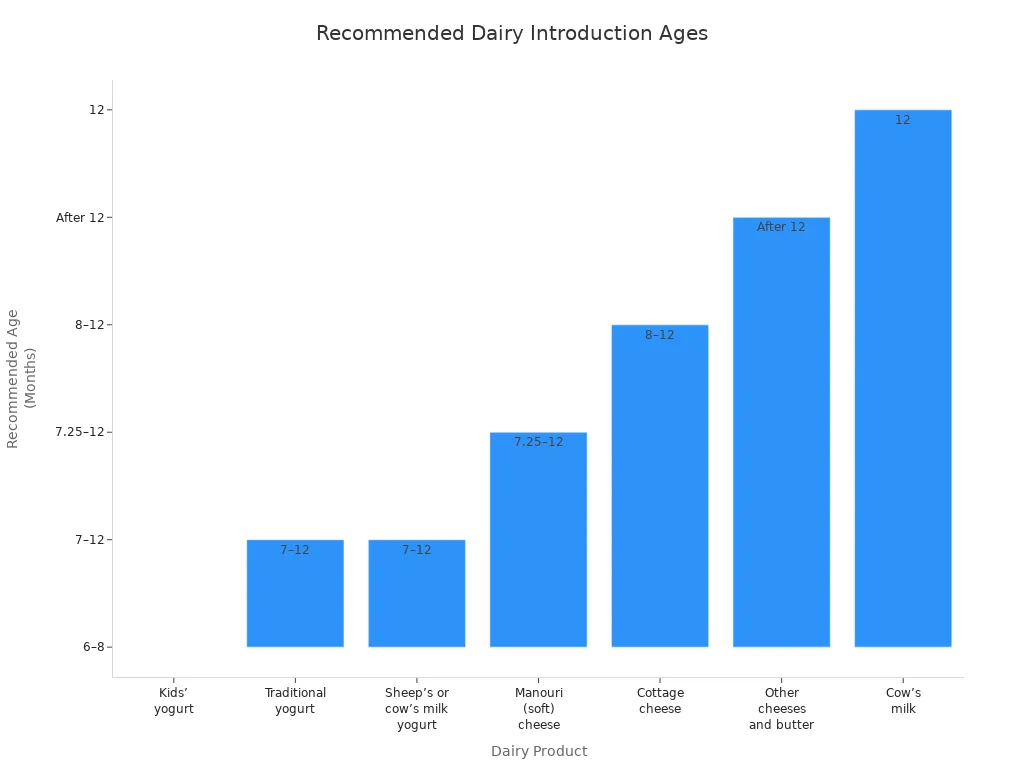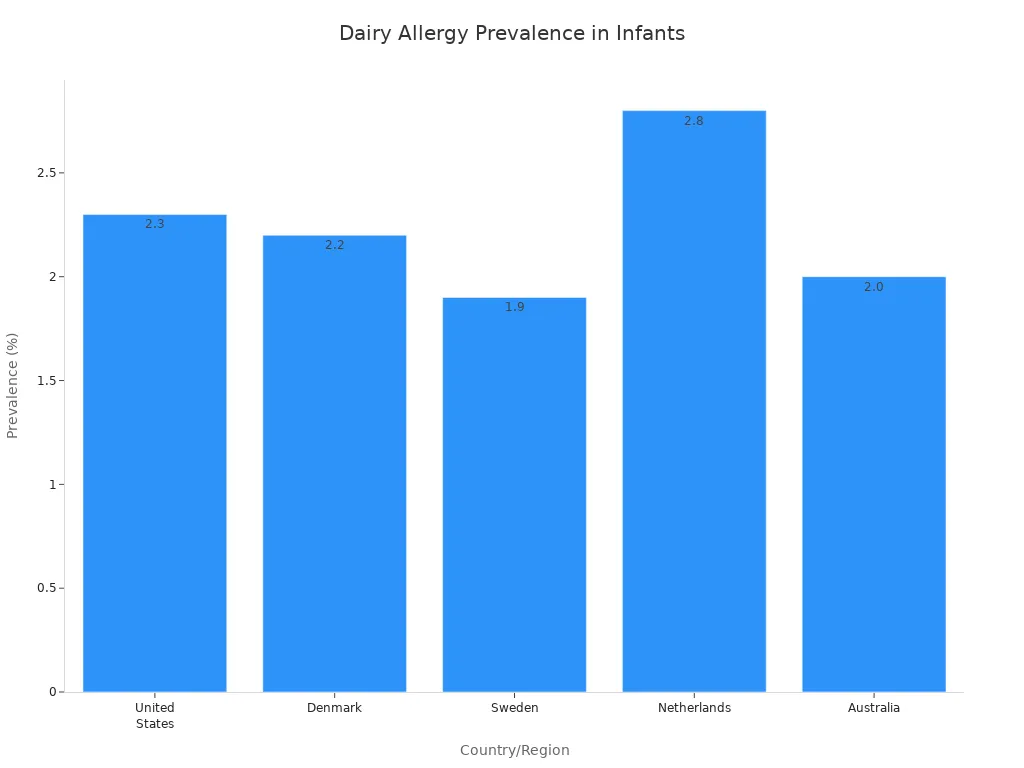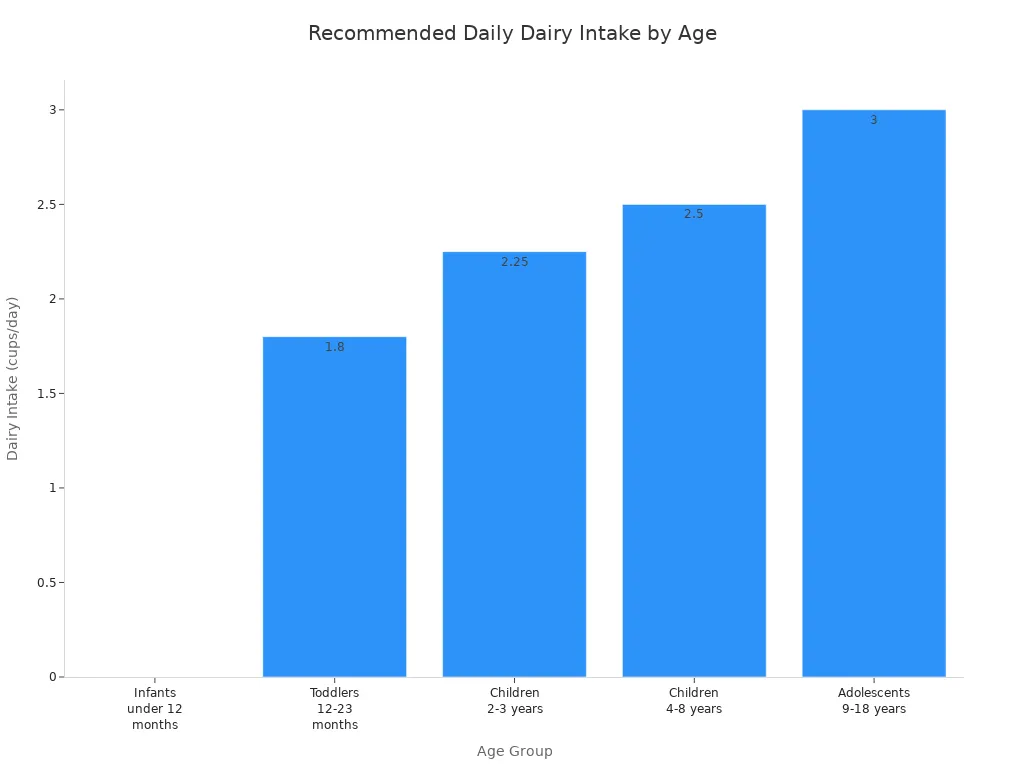You might be unsure about how to safely introduce dairy to baby diet because of worries about allergies, lactose intolerance, or whether your baby will enjoy the taste.
Experts recommend waiting until your baby is one year old before offering whole cow’s milk as a drink, which is an important part of how to safely introduce dairy to baby diet.
Some babies may develop hives or vomit due to an allergy, while others might just experience gas or bloating. If you have any concerns about how to safely introduce dairy to baby diet, talking to your pediatrician can help guide you through each step.
Key Takeaways
- You can start giving your baby dairy foods like yogurt and cheese at about 6 months old, but wait until your baby is over one year old before giving cow’s milk to drink.
- Pick plain, full fat dairy foods with no added sugar to help your baby grow and support brain health.
- Add dairy slowly by mixing small amounts into foods your baby already likes, and watch closely for any allergy signs.
- If your baby gets a rash or throws up, stop giving dairy and call your pediatrician right away.
- Be patient and try different dairy textures and ways to serve them so your baby can enjoy new flavors and learn healthy eating habits.
When to Start Dairy
Age Guidelines
You might wonder when your baby can try their first taste of dairy. Pediatricians agree that timing matters for your child’s health. Cow’s milk as a drink should wait until after your baby turns one.
Before that, you can offer other dairy foods like yogurt and cheese once your baby starts eating solids, usually around 6 months.
This approach matches the advice from the American Academy of Pediatrics, which says to introduce a variety of foods, including dairy, during the complementary feeding period.
Here’s a quick look at the most common age milestones for introducing dairy:
| Age Milestone | Dairy Introduction Guidance |
|---|---|
| Birth to 6 months | Human milk and/or formula recommended as primary nutrition. Cow’s milk not recommended. |
| 6 to 9 months | Continue breast milk/formula. You can mix small amounts of cow’s milk into foods, but not as a drink. |
| 9 to 12 months | Soft foods like cheese cubes can be added. Cow’s milk still not recommended as a drink. |
| After 12 months | Cow’s milk and alternatives can be used as drinks, replacing formula or breast milk. |
You can also see how pediatricians recommend introducing different dairy products in this chart:

Starting dairy at the right time helps your baby get important nutrients like calcium, which supports strong bones and healthy growth.
Studies show that kids who eat dairy at the recommended ages have a lower risk of obesity and stronger bones later in life.
Signs Baby Is Ready
Not sure if your baby is ready for dairy? Look for these signs:
- Your baby sits up with little or no support.
- They show interest in what you’re eating.
- They can move food from a spoon into their mouth.
- They swallow food instead of pushing it out with their tongue.
Tip: Always start with small amounts and watch for any signs of allergy, like rash or tummy trouble. If you have any concerns, check with your pediatrician.
Introducing dairy can feel like a big step, but with these guidelines, you can feel confident about when and how to start.
How to Safely Introduce Dairy to Baby Diet
First Dairy Foods
When you want to know how to safely introduce dairy to baby diet, you should choose the right foods. Most experts say to start with plain, full fat yogurt or soft cheeses like cottage cheese.
These foods are gentle on your baby’s stomach and easy to mix with other foods. You can give your baby small tastes of yogurt or cheese at about 6 months, after your baby starts eating solids.
Do not give cow’s milk as a drink before your baby turns one. Cow’s milk is hard for babies to digest and does not have the right nutrients.
Babies under two years old need full fat dairy. The extra fat helps your baby’s brain grow and gives energy. Low fat or skim dairy does not give babies what they need now.
Also, do not use milk alternatives like almond or soy milk before your baby turns one. These do not have enough protein or healthy fat for babies.
Pick plain yogurt and cheese with no added sugar or flavors. Babies do not need extra sugar in their food.
Mixing Dairy Into Meals
You may wonder how to safely introduce dairy to baby diet without causing stomach problems or allergies. The best way is to start with a small amount and mix dairy into foods your baby already likes.
For example, you can stir a little plain yogurt into mashed banana, sweet potato, or baby cereal. This helps your baby get used to dairy’s taste and texture while you watch for any reactions.
Here is an easy way to mix dairy into your baby’s meals:
- Begin with a tiny amount, like 1/8 teaspoon of plain yogurt.
- Mix it into 1 or 2 tablespoons of a food your baby already eats, like fruit puree or cereal.
- Give this mixture 2 or 3 times each week.
- If your baby does well, slowly add more dairy each week.
This way of introducing dairy can help your baby’s immune system learn that dairy is safe. Studies show that early, slow exposure to dairy—especially between 4 and 6 months—can lower allergy risk, especially if your baby has eczema or family allergies. Breastfeeding during this time also helps protect your baby’s gut and immune system.
Note: Always watch your baby for allergy signs, like rash, vomiting, or trouble breathing. If you see these, stop dairy and call your doctor.
Gradual Introduction
Learning how to safely introduce dairy to baby diet means going slow. Health experts say to add only one new food at a time.
After you give your baby a new dairy food, wait 2 or 3 days before trying another new food. This makes it easier to see if your baby has an allergic reaction. Most reactions to dairy show up fast, often within two hours, but waiting a few days is still safest.
Some parents use a method called the “milk ladder.” You start with dairy in baked foods, then move to yogurt, cheese, and finally cow’s milk as a drink after your baby turns one. This step by step way works well for most babies and keeps reactions mild.
Let’s see how gradual introduction compares to other ways:
| Study / Protocol | Method of Dairy Introduction | Adverse Reaction Rate | Treatment Completion Rate | Notes |
|---|---|---|---|---|
| Calvo et al. (2007-2018) | Gradual dose increase | Low, implied by high success | 98%+ | Gradual steps over 2-3 months, under supervision |
| Single low dose exposure study | Single low dose exposure | 10% mild reactions | 100% | All mild, no serious events, all completed ladder |
| Milk ladder introduction | Gradual stepwise increase | Minimal, manageable | 65% at 6 months, 54% at 12 months | Higher completion than control group |
As you can see, gradual introduction leads to fewer and milder reactions. Most babies finish the process without problems. If your baby has a history of cow’s milk allergy, always talk to your doctor before starting dairy.
The key to how to safely introduce dairy to baby diet is patience. Go slow, watch for reactions, and enjoy this new stage with your baby.
Choosing the Right Dairy
Full Fat vs. Low Fat
When you pick dairy for your baby, always go for full fat options. Babies between 6 and 24 months need the extra fat for brain growth and energy.
Low fat dairy does not give enough healthy fats for your baby’s needs. Fat also helps your baby absorb important vitamins.
Here’s a quick look at how full fat and low fat dairy compare for toddlers:
| Nutrient/Outcome | Full Fat Dairy (Cow’s Milk) | Low Fat/Fortified Dairy |
|---|---|---|
| Protein | Higher | Lower |
| Saturated Fat | Higher | Lower |
| Carbohydrates | Lower | Higher |
| Iron | Lower | Higher |
| Vitamins B6 & B12 | Higher | Lower |
| Body Fat Percentage | Higher | Lower |
Babies under 12 months should never have low fat dairy. Their brains and bodies need the fat from whole milk products.
Yogurt, Cheese, and More
You can start with plain, full fat yogurt or soft cheese once your baby begins solids, usually around 6 months. Greek yogurt is a great choice because it is thick and easy for babies to eat.
Always pick pasteurized products to keep your baby safe from germs. Avoid yogurts with added sugar or honey.
Yogurt and cheese are easier to digest than cow’s milk because they are cultured. They also help build a healthy gut. If your baby cannot have dairy, look for unsweetened, fortified plant based yogurts, but remember these may have less protein and fat.
Tip: Mix plain yogurt with fruit puree for a tasty snack. Skip store bought yogurt melts—they often have added sugar.
Cow’s Milk and Alternatives
Do not give cow’s milk as a drink before your baby turns one. Cow’s milk can cause tummy troubles, strain the kidneys, and even lead to iron deficiency anemia.
Your baby’s digestive system is not ready for it yet. Breast milk or formula should stay the main drink until 12 months.
Cow’s milk as a drink before 12 months can:
- Cause tiny bleeds in the gut
- Make it hard for your baby to get enough iron
- Overwork your baby’s kidneys
Milk alternatives like almond or oat milk are not good choices for babies under one year. They do not have enough protein or calories. After your baby turns one, you can try fortified soy milk if needed.
If you can, choose organic or pasture raised dairy. These options have more healthy fats and fewer chemicals, which is better for your growing baby.
Allergy Awareness
Signs of Dairy Allergy
You may wonder how dairy allergy shows up in babies. Symptoms can appear fast, sometimes just minutes after eating dairy.
Other times, it takes up to two hours. Some symptoms are mild, but others are very serious. Here is a table that lists the most common symptoms:
| Symptom Category | Common Symptoms in Infants with Dairy Allergy |
|---|---|
| Gastrointestinal | Vomiting, colic, diarrhea, constipation, rectal bleeding, blood or mucus in stool |
| Cutaneous (Skin) | Eczema, hives (urticaria), swelling (angioedema), rashes |
| Respiratory | Wheezing, coughing, runny nose, swelling in the throat |
| Severe Reactions | Anaphylaxis (trouble breathing, drop in blood pressure) |
| Other | Poor weight gain, failure to thrive |
Most babies will not get a dairy allergy. Still, it is the most common food allergy for infants. In the U.S., about 2% of babies have a dairy allergy. You can see how this number compares in other countries:

What to Do If Allergic
If you see any of these symptoms, act fast. Here are some steps you can take:
- Stop giving your baby dairy right away.
- Call your pediatrician and tell them what happened.
- If your baby drinks formula, your doctor may suggest a hypoallergenic formula.
- If you breastfeed, your doctor might ask you to avoid dairy, but only if they say so.
- Your doctor may use a “milk ladder” to slowly bring back dairy. This starts with baked milk foods, then yogurt and cheese. Always follow your doctor’s advice for this.
Tip: Never try to give dairy again by yourself if your baby had a bad reaction. Always ask your doctor first.
When to Call the Doctor
Call your doctor if your baby has any allergy signs after eating dairy. If your baby has trouble breathing, swelling of the lips or face, or seems very sick, call 911 right away.
For mild problems like rash or tummy pain, call your pediatrician for advice and possible allergy testing. Your doctor can help you make a safe plan for feeding your baby and answer your questions about dairy allergies.
Tips for a Smooth Transition
Serving Ideas
You can make dairy fun and easy for your baby. Try mixing plain yogurt with fruit or veggie purees for a colorful snack. Babies love to dip, so spread yogurt on toast sticks or stir it into hummus. You can also blend yogurt with fruit and freeze it into popsicles—perfect for teething or hot days.
Grated cheese works well on pasta or veggies, and small cubes of soft cheese are great for self feeding. If your baby enjoys eggs, mix in a little ricotta or cream cheese for extra creaminess.
Want to get creative?
Make a simple smoothie with milk, banana, and berries. You can even sprinkle Parmesan on meatballs or pasta. For older babies, grilled cheese sandwiches cut into tiny pieces are a hit. These ideas help your baby explore new tastes and textures while getting the nutrients they need.
Handling Refusal
Sometimes babies turn up their noses at dairy. Don’t worry—this is normal. You can try different textures and temperatures.
Some babies like cold yogurt, while others prefer it at room temperature. If your baby refuses milk, offer it only at meals and snacks, not all day. This helps your child see milk as part of eating, not just a comfort drink.
Here are some helpful strategies:
| Strategy | Why It Helps |
|---|---|
| Offer milk at meals | Builds routine and reduces overreliance |
| Use smaller portions | Makes new foods less overwhelming |
| Switch to cups after age 1 | Supports development and reduces bottle dependence |
| Try non-dairy alternatives if needed | Soy milk is a good option if dairy is not tolerated |
Stay patient and keep offering dairy in different ways. Sometimes it takes several tries before your baby accepts a new food.
How Much Dairy
You might wonder how much dairy your baby needs. Health experts recommend introducing yogurt or cheese around 6 months, but breast milk or formula should stay the main drink until your baby turns one. After the first birthday, you can offer whole milk as a drink.
Here’s a quick guide:
| Age Group | Daily Dairy Amount |
|---|---|
| Under 12 months | Breast milk or formula; small amounts of yogurt or cheese |
| 12–23 months | 1⅔ to 2 cups (whole milk or dairy foods) |
| 2–3 years | 2 to 2½ cups |

Remember, every baby is different. Watch for signs of fullness and adjust as needed. If you have questions, your pediatrician can help you find the right balance.
You can feel confident about how to safely introduce dairy to baby diet by following these steps:
- Breastfeed exclusively for the first 6 months.
- Start solids, including yogurt or cheese, around 6 months.
- Offer whole cow’s milk as a drink after your baby turns one.
- Limit cow’s milk to about 16 ounces daily for toddlers.
- Watch for allergy signs and talk to your pediatrician if you have concerns.
For more guidance, check out resources from the American Academy of Pediatrics or Nestlé Health Science. These sites offer tips, recipes, and tools to help you every step of the way.
FAQ
When can I give my baby cow’s milk as a drink?
You should wait until your baby turns one before offering cow’s milk as a drink. Before that, stick with breast milk or formula. You can use small amounts of yogurt or cheese after 6 months.
What if my baby refuses dairy foods?
Don’t stress! Babies often need time to accept new flavors. Try offering dairy in different ways, like mixing yogurt with fruit or adding cheese to veggies. Keep trying—most babies learn to enjoy dairy with repeated exposure.
Can I use plant based milk for my baby?
You should avoid plant based milks like almond or oat milk before your baby turns one. These do not have enough protein or fat for healthy growth. After age one, you can use fortified soy milk if your pediatrician agrees.
How do I know if my baby is allergic to dairy?
Watch for signs like rash, vomiting, diarrhea, or trouble breathing after eating dairy. If you notice any of these, stop giving dairy and call your doctor right away. Quick action keeps your baby safe.



